Razer Orca goes hunting
Razer, a monster of the gaming periphery, has a very interesting approach to choosing names for new devices - mice are traditionally named after snakes, keyboards are named after spiders, rugs are named after beetles, and audio systems are named after fish, sharks and other shark-like mammals. Today we are talking about a new "animal" called Orca - Wikipedia says that this was the name of the predatory killer whale from the sensational film of the same name.
Under the cut, there are three devices and pretty girls;)
Actually, when I had not yet read about the features of these headphones, I thought that they were the same Razer Megalodon , but without an external sound card and all the technologies resulting from it. That is, such a simple gaming headset, quite budget.
But in reality, everything turned out to be a little different.


Razer Orca - this is not a headset (it does not have a microphone), but the most ordinary headphones, outwardly almost completely repeating their "big brother". Not only externally, but also constructively - the same thick and durable headband, the same metal rods, thanks to which the "ears" can be worn on any head. The same braided wire (though a little thinner), which does not freeze in the cold.

And, of course, those big "cups" inside which are warm velvet ear pads, from which the ears do not get tired and do not hurt. These are one of the few ears in which you can be without discomfort for a long time; lip size is very good - it's not as small as, for example, in the Audio-Technica the ATH-ES7 , but not as great as in the ATH-AD1000 from the same manufacturer.

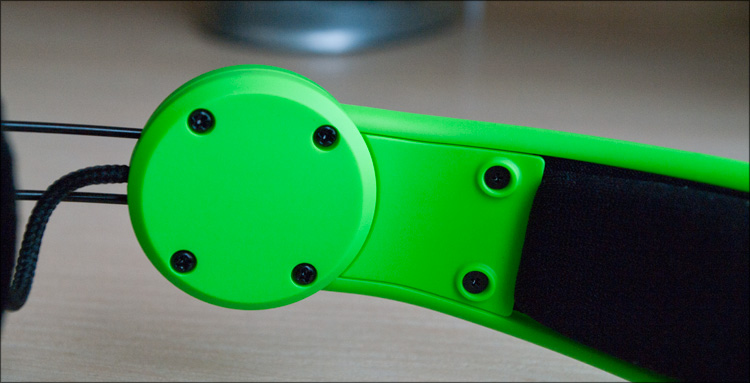

I do not see the point of describing the appearance again - everything said in the Razer Megalodon review is valid for the Razer Orca. True, there are slight differences - as I said, there is no swivel microphone and sound processing unit. Accordingly, there was no need for a USB interface - it was replaced by the usual direct 3.5 mm mini-jack.

And since the power supply on this solemn note was over, then all the lights disappeared - in particular, the company logo in the form of three snakes:
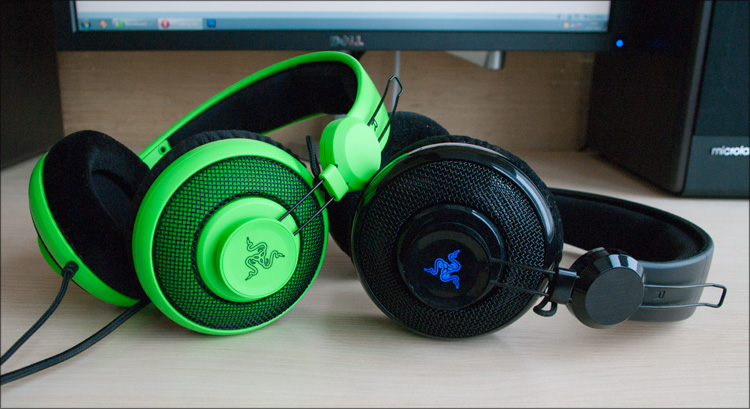
Usually, Razer comes up with a fantasy for packing gadgets, but this time it's pretty simple - the headphones are half walled up in cardboard, the rest is visible through a small cutout in the box. The complete set is no frills - ears, extension cord and instructions. It's nice that this time the headphones completely got rid of the gloss. From the headphones (on the left side) there is one wire in a braid made of fabric - its length is 1.2 meters comfortable for the “portable”, although there is a two-meter extension cord in the kit that you can “leave” in the computer to connect your ears to it at home. The docking of the wire with the headphones themselves is very reliable, unlike the same expensive ATH-AD1000.


In terms of sound reproduction, the headphones are somewhat similar ... but this is if you compare ordinary music. Although this comparison is somewhat incorrect due to different sound sources for any of the possible connection options. I mean the detail, the bass, and all of this stuff is the same.
Finally, I stood out to listen to these ears in a really noisy place - the noise insulation is quite good (the metro is almost inaudible), but many “plugs”, as they expect it, “Orkov” are put into the belt for noise isolation.
The differences begin in solid games, the developers of which at the development stage did not spare money for such an important part of the game as sound. In this scenario, Razer Megalodon are clearly leaders - Razer Maelstrom technology(which I wrote about in detail last time) really works wonders, dividing all the sound into several channels and digging it all into the ears - in the “crisis” you can hear who is shooting from where, and in the same Need For Speed Hot Pursuit you can hear it clearly, for example that the spikes fly precisely from behind the car, and not from somewhere in the astral plane. The processing of all this without prejudice to the performance of the computer is handled by an external data processing unit with sound control buttons, since Razer Orca doesn’t have all this, they won’t be able to replace the 7.1 system even if they really want to. It's just headphones ... on which, however, you can also play pretty well. But if suddenly you arean 80th level elfabsolutely pros and sound in the game are not just a “background” for you, but a functional component, it’s better to play definitely on an “adult” model.

The Internet is somewhat misinformed, saying that with the ears there is software for switching Gaming / Music modes, and also that there is a similar switch on the wire - there is neither one nor the other. On my pics is somewhat unfair color headphones - green color is not as rich as it is in reality;) The most accurate he transferred here .
I can say one thing - I have been using rather expensive Razer Megalodon headphones for more than a year and have still not found any serious flaws in them. They are initially positioned as gaming, but nothing prevents you from watching movies, listening to music, chatting on Skype or writing podcasts - the microphone is very OK there. Amazing box for transportation, comfortable headphone stand ... I liked everything straight! But, unfortunately, you can’t attach them to the player because of the “binding to the hospital” - a USB connection, a non-removable signal processing unit ... and a microphone somewhere in the subway would look rather ridiculous.
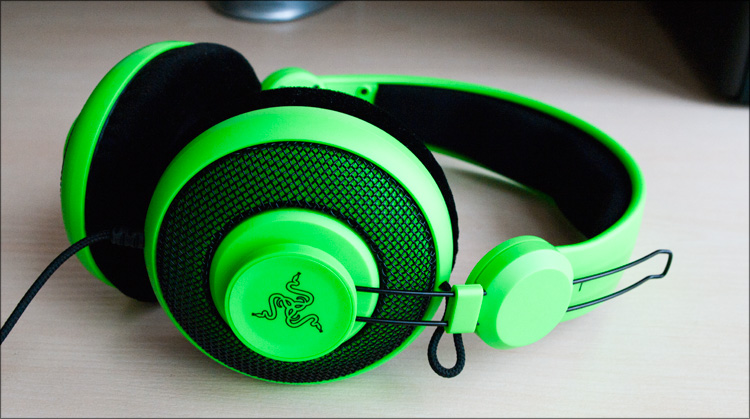
And then take and appear Razer Orca - an aria from the same opera, but now in a portable version. The advantages remained largely, and the cons turned into halves of the pros - all this is now offered for three times less money, for 2600 rubles. It is hoped that the older model will also inherit reliability, which “everyday” headphones will come in handy.
I don’t know what you would do, but with great pleasure for the winter period I changed the good soundproofing of the “plugs” to comfortable like slippers, warm and no less good-sounding Razer Orca. They sit comfortably and reliably on the head, without turning it into a "spacesuit" of enormous size. The only thing that causes some doubts is the acidic green color ... as agent Smith, I dress mostly in black (I love this color because the colors haven’t been invented yet) and the “poisonous headphones” harmoniously decorated my monotony with my riot of colors. But the reaction of the acquaintances was very mixed - from “ Wow, I like that - very unusual! "To" Uh, what kind of frivolous hipster shnyag ?! ":) So it's up to you to decide - color really breaks patterns)


Frequency Response Range : 15 - 21000 Hz
Maximum Power Consumption : 200 mW
Sensitivity (1 kHz, 1 V / Pa) : 102 ± 4 dB
Speakers : 40 mm, neodymium magnetic
Impedance : 32 Ohms at 1 kHz
Connector : 3.5 mm mini Jack, straight
Wire : 1.2 meters, in a protective fabric braid + 2 meter extension cord

Well, since we started talking about sound, let me briefly tell you about another device - I want to share my impressions, but to do this for a separate post - no. In general, I put together a new computer, I gave it to my wife - everything is ok, but without speakers. Skype, cartoons for a child or just music for the background - headphones can’t do here. Buying something high-quality / expensive - in this case, is completely useless, and the holidays are unsettled. In general, we chose the color)
Speedlink Vivente 2.1- budget home acoustics, available in several colors. Inside a convenient (for transportation) box - a sub, two tiny speakers and wires. Absolutely everything is made of plastic, but after connecting it seems to work and seems to be tolerable for its price (2100, a little cheaper than the headphones about which I wrote above). Frequency response is not, and whether they are needed;)
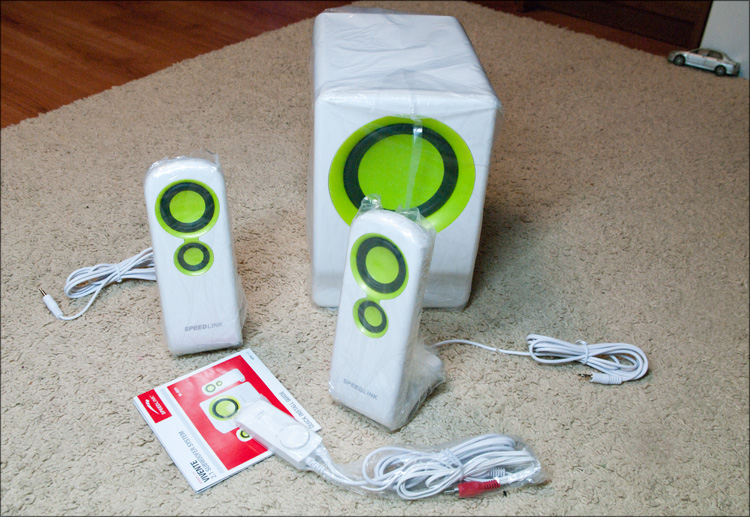
Everything is connected to the subwoofer, including the “remote control”, if you can call it that.
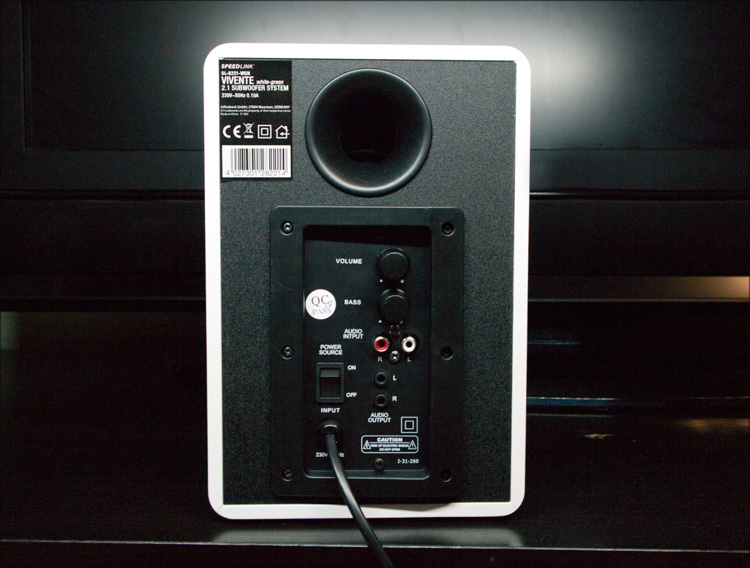
A small device with a volume control, for which for some reason there are already two wires, although, as practice has shown, they do everything with one.
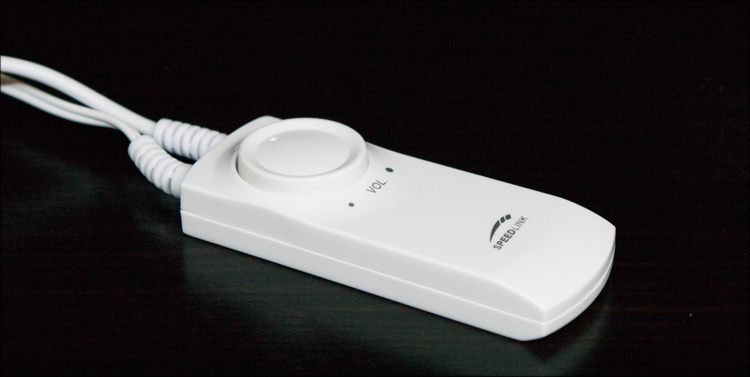
Speakers take up very little space, which was one of the key requirements when buying - despite their bizarre shape, they are quite stable. At the bottom they have a green LED that creates a nice glow around the speakers (in the dark).
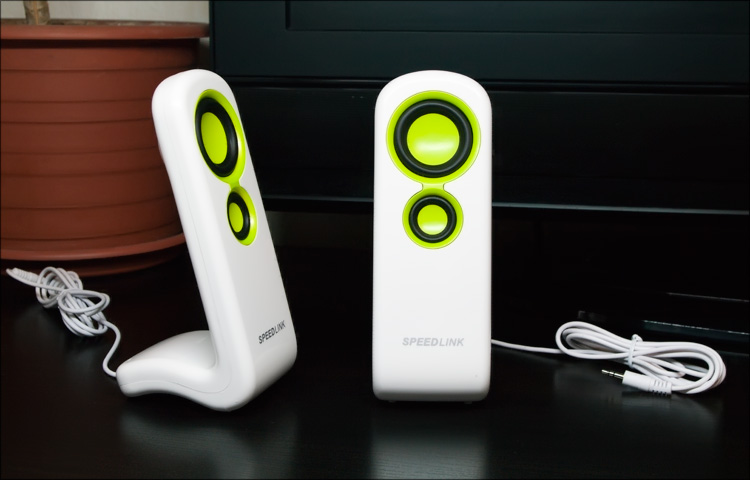
Not that I urge you to buy these speakers) But I bought them as a consumable (a printer cartridge is more expensive), put it once and forgot it. The feeling of something frankly Chinese does not leave, but the requirements were primitive. They cope with their task - so as a budget option somewhere to replace the speakers of the laptop, in the office, in the garage, or like ours, home - completely.
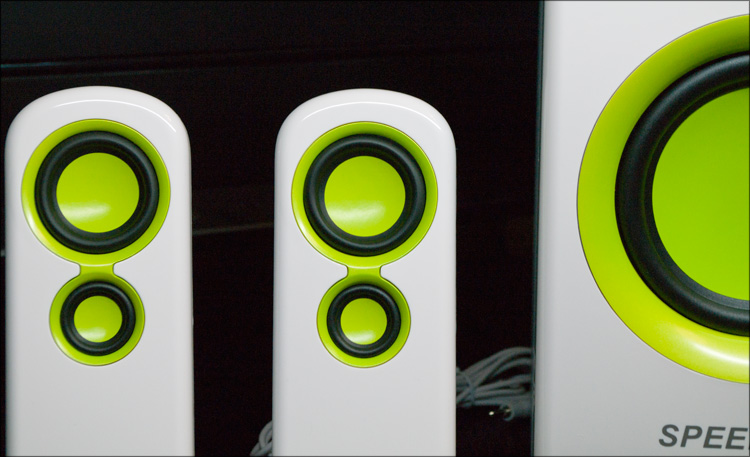
RMS output power : 12 W (satellites 2 x 3 W, subwoofer 6 W)
Range of working frequencies of satellites : 140 Hz - 20 kHz
Range of working frequencies of subwoofer : 40 Hz - 200 Hz
Resistance : satellites - 4 Ohms, subwoofer - 6 Ohms
Dimensions of satellites : 70 x 195 x 95 mm
Subwoofer dimensions : 162 x 220 x 235 mm
Cable : 1.3 m
Weight : 2.5 kg
That's it.
These are New Year’s affairs. Tell me, what’s better - do a review while the piece of iron is just out and still fresh, or use it carefully, but write more objectively? Your opinion is interesting, because the option "get it in a week and write a thorough fresh" does not always work :)
PS I heard that Razer is preparing something tasty;) Happy New Year

!


Razer Orca - this is not a headset (it does not have a microphone), but the most ordinary headphones, outwardly almost completely repeating their "big brother". Not only externally, but also constructively - the same thick and durable headband, the same metal rods, thanks to which the "ears" can be worn on any head. The same braided wire (though a little thinner), which does not freeze in the cold.

And, of course, those big "cups" inside which are warm velvet ear pads, from which the ears do not get tired and do not hurt. These are one of the few ears in which you can be without discomfort for a long time; lip size is very good - it's not as small as, for example, in the Audio-Technica the ATH-ES7 , but not as great as in the ATH-AD1000 from the same manufacturer.



I do not see the point of describing the appearance again - everything said in the Razer Megalodon review is valid for the Razer Orca. True, there are slight differences - as I said, there is no swivel microphone and sound processing unit. Accordingly, there was no need for a USB interface - it was replaced by the usual direct 3.5 mm mini-jack.

And since the power supply on this solemn note was over, then all the lights disappeared - in particular, the company logo in the form of three snakes:

Usually, Razer comes up with a fantasy for packing gadgets, but this time it's pretty simple - the headphones are half walled up in cardboard, the rest is visible through a small cutout in the box. The complete set is no frills - ears, extension cord and instructions. It's nice that this time the headphones completely got rid of the gloss. From the headphones (on the left side) there is one wire in a braid made of fabric - its length is 1.2 meters comfortable for the “portable”, although there is a two-meter extension cord in the kit that you can “leave” in the computer to connect your ears to it at home. The docking of the wire with the headphones themselves is very reliable, unlike the same expensive ATH-AD1000.


In terms of sound reproduction, the headphones are somewhat similar ... but this is if you compare ordinary music. Although this comparison is somewhat incorrect due to different sound sources for any of the possible connection options. I mean the detail, the bass, and all of this stuff is the same.
Finally, I stood out to listen to these ears in a really noisy place - the noise insulation is quite good (the metro is almost inaudible), but many “plugs”, as they expect it, “Orkov” are put into the belt for noise isolation.
The differences begin in solid games, the developers of which at the development stage did not spare money for such an important part of the game as sound. In this scenario, Razer Megalodon are clearly leaders - Razer Maelstrom technology(which I wrote about in detail last time) really works wonders, dividing all the sound into several channels and digging it all into the ears - in the “crisis” you can hear who is shooting from where, and in the same Need For Speed Hot Pursuit you can hear it clearly, for example that the spikes fly precisely from behind the car, and not from somewhere in the astral plane. The processing of all this without prejudice to the performance of the computer is handled by an external data processing unit with sound control buttons, since Razer Orca doesn’t have all this, they won’t be able to replace the 7.1 system even if they really want to. It's just headphones ... on which, however, you can also play pretty well. But if suddenly you are

The Internet is somewhat misinformed, saying that with the ears there is software for switching Gaming / Music modes, and also that there is a similar switch on the wire - there is neither one nor the other. On my pics is somewhat unfair color headphones - green color is not as rich as it is in reality;) The most accurate he transferred here .
I can say one thing - I have been using rather expensive Razer Megalodon headphones for more than a year and have still not found any serious flaws in them. They are initially positioned as gaming, but nothing prevents you from watching movies, listening to music, chatting on Skype or writing podcasts - the microphone is very OK there. Amazing box for transportation, comfortable headphone stand ... I liked everything straight! But, unfortunately, you can’t attach them to the player because of the “binding to the hospital” - a USB connection, a non-removable signal processing unit ... and a microphone somewhere in the subway would look rather ridiculous.

And then take and appear Razer Orca - an aria from the same opera, but now in a portable version. The advantages remained largely, and the cons turned into halves of the pros - all this is now offered for three times less money, for 2600 rubles. It is hoped that the older model will also inherit reliability, which “everyday” headphones will come in handy.
I don’t know what you would do, but with great pleasure for the winter period I changed the good soundproofing of the “plugs” to comfortable like slippers, warm and no less good-sounding Razer Orca. They sit comfortably and reliably on the head, without turning it into a "spacesuit" of enormous size. The only thing that causes some doubts is the acidic green color ... as agent Smith, I dress mostly in black (I love this color because the colors haven’t been invented yet) and the “poisonous headphones” harmoniously decorated my monotony with my riot of colors. But the reaction of the acquaintances was very mixed - from “ Wow, I like that - very unusual! "To" Uh, what kind of frivolous hipster shnyag ?! ":) So it's up to you to decide - color really breaks patterns)


Specifications Razer Orca
Frequency Response Range : 15 - 21000 Hz
Maximum Power Consumption : 200 mW
Sensitivity (1 kHz, 1 V / Pa) : 102 ± 4 dB
Speakers : 40 mm, neodymium magnetic
Impedance : 32 Ohms at 1 kHz
Connector : 3.5 mm mini Jack, straight
Wire : 1.2 meters, in a protective fabric braid + 2 meter extension cord

Well, since we started talking about sound, let me briefly tell you about another device - I want to share my impressions, but to do this for a separate post - no. In general, I put together a new computer, I gave it to my wife - everything is ok, but without speakers. Skype, cartoons for a child or just music for the background - headphones can’t do here. Buying something high-quality / expensive - in this case, is completely useless, and the holidays are unsettled. In general, we chose the color)
Speedlink Vivente 2.1- budget home acoustics, available in several colors. Inside a convenient (for transportation) box - a sub, two tiny speakers and wires. Absolutely everything is made of plastic, but after connecting it seems to work and seems to be tolerable for its price (2100, a little cheaper than the headphones about which I wrote above). Frequency response is not, and whether they are needed;)

Everything is connected to the subwoofer, including the “remote control”, if you can call it that.

A small device with a volume control, for which for some reason there are already two wires, although, as practice has shown, they do everything with one.

Speakers take up very little space, which was one of the key requirements when buying - despite their bizarre shape, they are quite stable. At the bottom they have a green LED that creates a nice glow around the speakers (in the dark).

Not that I urge you to buy these speakers) But I bought them as a consumable (a printer cartridge is more expensive), put it once and forgot it. The feeling of something frankly Chinese does not leave, but the requirements were primitive. They cope with their task - so as a budget option somewhere to replace the speakers of the laptop, in the office, in the garage, or like ours, home - completely.

Technical specifications Speedlink Vivente 2.1
RMS output power : 12 W (satellites 2 x 3 W, subwoofer 6 W)
Range of working frequencies of satellites : 140 Hz - 20 kHz
Range of working frequencies of subwoofer : 40 Hz - 200 Hz
Resistance : satellites - 4 Ohms, subwoofer - 6 Ohms
Dimensions of satellites : 70 x 195 x 95 mm
Subwoofer dimensions : 162 x 220 x 235 mm
Cable : 1.3 m
Weight : 2.5 kg
That's it.
The end
These are New Year’s affairs. Tell me, what’s better - do a review while the piece of iron is just out and still fresh, or use it carefully, but write more objectively? Your opinion is interesting, because the option "get it in a week and write a thorough fresh" does not always work :)
PS I heard that Razer is preparing something tasty;) Happy New Year

!
